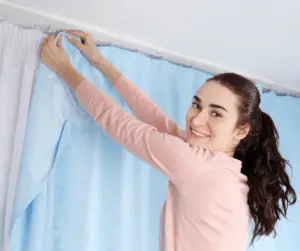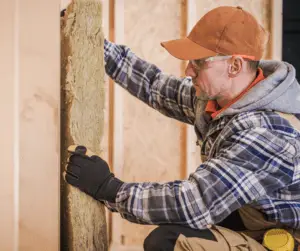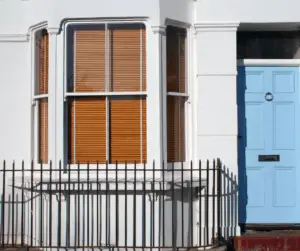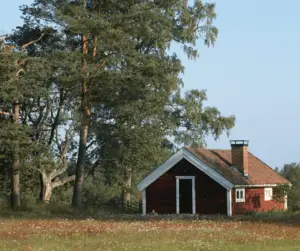If you don’t have an air conditioner but want to avoid sweating down to the bone, I’ve got some great tips for you.
I’ve spent a lot of time off-grid with no access to air-conditioning, so I’m very familiar with what it feels like to get hot in a home without that luxury.

For most people, looking for ways to stay cool without air conditioning can be for a few reasons. For one, it saves electricity, and if you use solar panels, then you know just how finite it can be.
Plus, if you opt for other ways to stay cool in your homestead, you won’t need to invest a lot of money into central air, which can be very pricey.
I’ve listed my favorite ways to stay cool without air conditioning, so I’m sure you’ll find at least a few tips that will result in you staying cool during the summer.
Lastly, I will cover why it may be a good idea to avoid having an air conditioner; I know, that seems backward, right? Let’s jump into it now.
15 Tips To Stay Cool Without Air-Conditioning
1: Install Curtains
The first tip is to install curtains on every window in your home. The sun can easily penetrate through the window and heat your home.
There is a reason why your car gets so hot during the summertime because the sun has a direct path straight into the interior.
If you opt for curtains, make sure they’re light in color and thick, as thinner curtains will not help as much. However, thin curtains do have a place, which is covered further in the article.
2: Create Cross Breezes
Opening your window is a great way to get a breeze going, but there is a better way of approaching this. If you open a window, then open a window in another room too.
This will create a cross draft, which is essentially going to cause a pretty significant flow of air between the opened windows, even if they’re in a separate room.
This works best if you open all windows, but two are needed at a minimum. Note that you should have all doors open to get the most out of it.
3: Insulate Well
Many people think that insulation is meant for the wintertime, and although it works great to keep heat in, it also works to keep the coolness in.
You’ll want to insulate the walls, attic, and floor, as these can all play a significant factor in the interior temperature. The best insulation for this is fiberglass, spray foam, and cellulose.
Insulating a roof well is particularly important if you have a tin roof, as the heat from the sun can quickly radiate through and heat the home more so than asphalt shingles.
4: Open Your Windows
We’ve already covered the cross draft section, but there is more than just cross drafts. A neat tip is to wet a light curtain to the point of heavy dampness and hang it near an open window.
This can also be done by using a large towel or other large sheets. It’ll cool the air coming into the home, resulting in a chilly wind to help you cool off.
You may also consider damping the curtain and freezing it. If you have a backup curtain, you can switch them out when one becomes too hot to cool off the interior by keeping the backup in the freezer.
5: Switch To LEDs
Incandescent bulbs, specifically, get very hot after they’ve warmed up. If you have more than a few on at a time, this can slightly raise the interior temperature.
To avoid this, switch over to LEDs, which burn at a significantly lower temperature. They will save you money, too, which could be why you’re reading this article.
LEDs also outlast incandescent bulbs by a significant amount, so the need to change them out will diminish from slim to none.
6: Icy Fan
This is a great way to keep your home cool, as it provides similar results to an air conditioner. You’ll need any sized fan and a bucket of ice sitting directly in front of the fan.
This will cause the air to flow over the cool ice, resulting in a chilly wind. If you don’t mind replacing ice every few hours, then this is a great option.
I’d suggest that you place the ice in a dryer basket that has holes on the upper side, this way, air can get in, and the water stays in too.
7: Install Window Film

If you’ve ever gotten your car tinted during the summertime, then you know how much of a difference it can make by keeping the interior cooler.
Tint can also be placed on the window in a home, and it works pretty well.
The home I lived in previously had tinted sliding windows, and the sun beat down on them all day, but it remained cool even on the hottest days.
8: Awnings
Another great tip is to install an awning, which will prevent the sun from hitting the window directly.
This is an even better consideration if you’re going to leave your windows open, as the air that enters your home will be even cooler.
Plus, they will provide shelter for when it’s raining, in case it’s hot during a downpour, these can be installed over doors, too.
9: Turn On The Bathroom Fan
As we all know, heat rises, which is why you duct down during a fire. We can use this to our advantage, though.
If you have an exhaust fan in your bathroom, then turn it on. It will suck out the hotter air that is near the ceiling and pull in cooler air elsewhere.
This isn’t going to make a huge difference, but it’ll help, that’s for sure.
10: Install Blinds
Blinds are the best line of defense against keeping the sun rays out of your home and raising the temperature.
If you opt for blinds, get wooden ones, since they will disseminate the heat adequately.
Plus, they can be slightly open while the window is open, allowing cool air to flow through. This is one of my favorite options because it works so well.
11: Dehumidifier
Summertime has an interesting climate. It may rain one day, and the next, the sun will break through and result in a high amount of humidity.
To avoid this, consider purchasing a dehumidifier, which will not only lower the humidity in your home but also act as a fan, depending on the type; humidity can make a warm day a very bad day.
12: Rotating Fans
I have used this method several times, and it works very well.
To start, place a small, rotating fan in each corner of the room, turn the rotating feature on, and boom, you now have a huge wind draft in your room.
This works best in smaller rooms, but if you place ice in front of each of them, it could potentially cool a living room or den.
13: Seal Drafts
I once moved into a new home. I had the air conditioning on nearly 24/7 because I could not get the temperatures down.
I went into the attic to check a few things, and I noticed a gap about a foot wide.
After sealing it, I was able to maintain a cool temperature. These drafts can be anywhere, so if you find one, seal it with spray foam.
14: Shade Trees
My off-grid home was built in the middle of the woods, literally. It was surrounded by tall, healthy trees, full of leaves.
It didn’t matter if it were 80 or 100 degrees, it almost always stayed cool inside, and it had a tin roof, which should say something.
Shade trees are a great consideration; just one or two will do just fine.
15: Set Fans To Counter-Clockwise
Ceiling fans are great to use if you don’t have an air conditioner. However, they can provide substantially more wind if you switch the fan into the counterclockwise mode.
This will help keep the entire home cool, including the higher area, such as near the ceiling.
Doing this will circulate the air around much better vs. when it’s in the regular clockwise mode.
Why Avoid Air Conditioning?
It’ll Save You Money
If you’ve not yet built your homestead, or perhaps you already have, but you’re debating the options, you may consider not having one installed in the first place.
Central air conditioners can be costly, not only for the unit itself but for a professional install and all the ducts that’ll be needed. The money you save can go into other projects on your homestead.
You’ll Have More Room
Central air conditioners can take up a lot of room, not only by using up an area the size of a closet but also by using space due to the ducts that’ll be running everywhere.
If you’ve ever been under a home or in an attic, you know that the ducts can be a huge space taker. This space could be used for things such as storing food, supplies, and more.
Your Battery Banks Will Last Longer
If you opt for a central air conditioner, then it’ll need to have a source of power. Since you’re on a homestead, your only power source is likely solar panels.
Solar panels take the sun’s energy and store it inside large, expensive battery banks. If you didn’t have an air unit, imagine how much less stress the batteries would go through.
Frequently Asked Questions
What Are The Top 3 Methods?
If I were to choose only three of the noted fifteen methods, it’d be wooden blinds, ice, and rotating fans, plus reversing the ceiling fans.
Those three together are going to provide the most breeze possible. You should make sure that the home is insulated well. Though.
Even if you implement all of those steps, inadequate insulation will make it very difficult to maintain a cooler temperature.
Which Will Cool Off My Home The Fastest?
This option is not going to last as long as some others before needing to refill, but a fan with ice is going to provide the results you’re looking for quicker than all other options.
It’s effortless to do, as mentioned before, but you’ll need the ice in a container that is at an angle; this way, the air can hit the ice.
If the ice is in a container that isn’t tilted, the air will go right over the surface without hitting the ice, which means it won’t work.
How Can I Save Power?
If you’re opting to avoid an air conditioner, it’s likely because you want to save on power. The number one way is by using energy star rated appliances.
You can get energy star rated personal fans, but there are also plenty of ceiling fans that are energy star approved.
Finally, avoid using anything that has a compressor. A regular window unit, while still an air conditioner, will have to use a lot more power than a typical fan with ice.
Verdict
If you’ve been struggling to keep your home cool during the summer months, then I hope I’ve delivered at least a few helpful ways to help you stay cool.
Although some of these options may not result in frigid temperatures, if you combine most of them, it’ll undoubtedly make a difference.
My final advice would be to install wooden blinds, and open a few windows, and switch on a few fans with ice, which will result in a cooling effect.
Lastly, try to dress lightly; this will help you stay cool. If you find yourself getting hot in bed, consider a cooling pillow and summertime blankets.
I hope you’ve found a few great tips here, and I wish you the best of luck in keeping cool during the summer.






